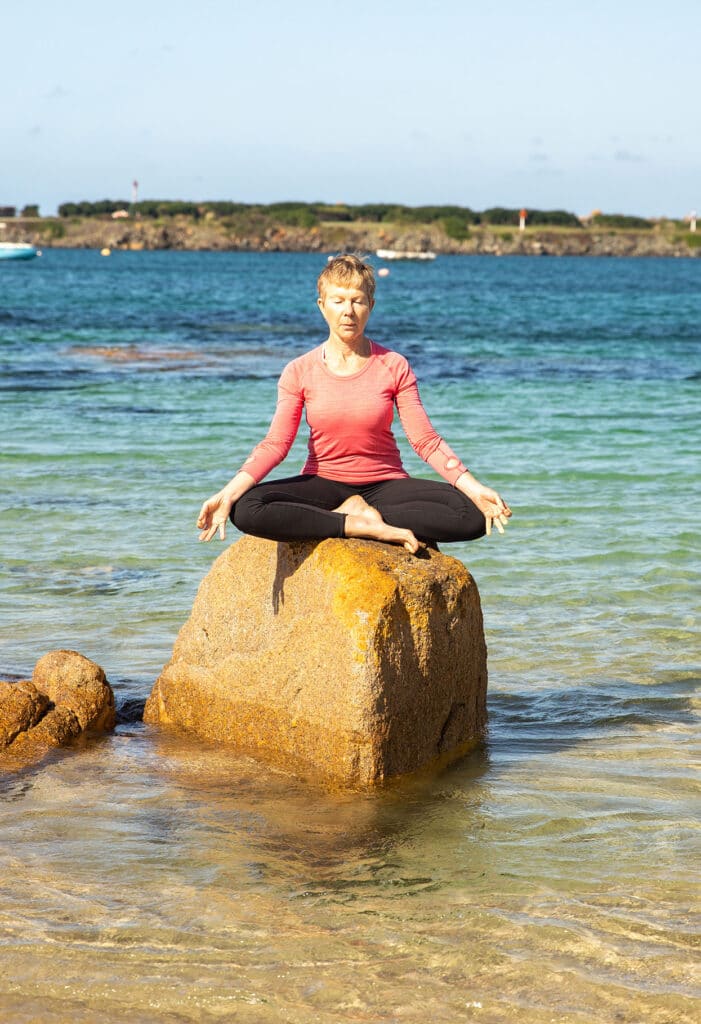Central to all the practises of yoga is the movement of prana, the life force or vital energy.
Prana is the energy permeating the universe at all levels. It is physical, mental, intellectual, sexual, spiritual & cosmic energy. All vibrating energies are prana.
It is the prime mover of activity. It is the energy which creates, protects & destroys. Vigour, power, vitality, life & spirit are all forms of prana.
Prana is in matter but is not matter. It is in air but is not oxygen. It is a subtle form of energy that is carried in air, food, water & sunlight & also animates all forms of matter.
Throughout the practices of asanas, pranayama & meditation more prana is taken in and stored in the body, bringing vitality & strength.
In addition to the physical body, yogis perceive man as possessing two other bodies, the subtle body & the causal body.
The astral body consists of 3 sub-sheaths, which are the Pranic sheath, mental sheath & intellectual sheath.
Prana is the vital link between the subtle, causal & physical bodies. It is stored & flows in the nadis or energy channels of the astral body. The subtle body stores the subtle impressions of Karma. These subtle impressions control the formation & growth of the two other bodies & determine every aspect of the next birth. At the time of death, both the causal & subtle bodies (which remain together) separate from the physical body.
Prana exists as a positive and negative energy & when stored in the subtle body is converted into 5 major branches called vayus or winds. Each vayu has its own special seat in the body and works to sustain us physically, mentally & spiritually.
1.PRANA VAYU – Forward wind is seated in the heart & stimulates & regulates the rising energy of reaching out & taking in – that is, appropriation or absorption. Its primary manifestation, though not it’s only one, is inhalation.
2.APANA VAYU – Downward wind is seated in the lower pelvis & stimulates & regulates the falling energy of elimination, menses, seminal fluid, birth or giving out or away. Its primary manifestation is exhalation.
3.SAMANA VAYU – Middle wind is the fire in the belly, seated in the navel. It stimulates & regulates assimilation or incorporation. Middle wind digests the food we take in from the world and “cooks” it transmuting it into energy.
4.VYANA VAYU – Circulating wind pervades the whole body and so has no specific seat. It is the glue that holds us together and the network that distributes what’s been digested to every cell. Circulating wind also urges us to openly share what we have assimilated to ourselves with the body of the world.
5.UDANA VAYU – Upward wind is the energy of expression, appropriately seated in the throat. It is the also the vehicle of the mind, namely of word & speech & thus in a certain sense, the medium of an enlarged individuality.
The five Vayus are not abstractions and not the preserve of just a few isolated Yogis’. They vitalise each of us, always & everywhere, whether we know it or not, with intelligence & creativity.
PRANAYAMA is the conscious prolongation of inhalation, retention, exhalation & retention. In Sanskrit the different stages of the breath are called: PURAKA (inhalation) ANTARA KUMBHAKA (holding inhalation) RECHAKA (exhalation) & BAHYA KUMBHAKA (holding exhalation).
The word prana is the combination of two syllables pra & na & denotes constancy, being a force in constant motion. Whereas prana is the vital force, pranayama is the process by which the internal pranic store is increased. Some people split the word Pranayama into Prana & Yama and define it as breath control. However, it is actually comprised of the words Prana & Ayama which means pranic capacity or length.
Technically speaking & according to Patanjali, pranayama is actually only RETENTION “…..Pranayama is the cessation of the movement of inhalation & exhalation…”
(Sutra 49).
Inhalation & exhalation are the methods of inducing retention. Retention is most important because it allows a longer period for the assimilation of prana, just as it allows more time for an exchange of gases in the cells.
The physiological purpose of pranayama is to improve the oxygenation, purification & circulation of blood & lymph. The outer aspect is exchanging gases between our blood and the air in our lungs; the inner aspect is exchanging gases between our blood and every cell in our body.
When we inhale to our lungs, the cells expire carbon dioxide into the venous blood. When we exhale from our lungs, our cells are inhaling oxygen from our blood. In order to purify every cell of waste products and to provide it with adequate oxygen, we must use our lungs fully. The more deeply we breathe, the more oxygen is available. This vitalizes every cell in our body and our vital organs, nervous system & specialized cells become more efficient. We become healthier.
By bringing to the cells the oxygen that they need to assimilate nutrients, pranayama develops a physical & mental vitality that becomes the root of good health & clear judgement. Pranayama or deep yogic breathing is a generator of energy. If our breath is shallow & unsteady, we find difficulty in maintaining adequate metabolic energy to ensure health. Then the energy we use for physical & mental activities drains our vitality and our vital organs become weak. If, however, we ensure a metabolic surplus of energy, we will have abundant reserves of energy for mental, creative, social & professional activities. This we can only do by ensuring both an adequate supply of nutrients form a healthy diet & REGULAR & DEEP BREATHING (PRANAYAMA).
By spending some time daily practising to extend the capacity of our lungs, our normal, habitual breathing becomes deeper & more consistent.
One aspect of the breath that is so fundamental that we take for granted is its relationship to our emotions. When we are upset or anxious, our breath becomes disturbed: it may be suspended, short & sharp, or heavy & laboured. We can calm disturbed emotions simply by regulating our breath. Just taking a deep full Yogi breath & letting it out slowly relaxes the body & mind by activating the relaxation response of the parasympathetic nervous system.
Pranayama therefore tends to generate a more tranquil, clam state of mind in which we are less prone to extreme or unpredictable emotional responses. By learning to control the flow of breath we are also learning to harmonise, calm & quieten the mind.
Inhalation is the act of receiving the primal energy in the form of breath, retention is when the breath is held to savour that energy & exhalation is the removal of toxins from the body and the surrender of ‘I’ or ego self.
On a higher level of experience, prana & consciousness are one. On the mundane level of existence, however, they are mutually related & interact with each other. They are in fact mutually dependent entities, at times merging & at times becoming separate. Prana can thus be affected by consciousness & vice versa.
On a spiritual level, by practising pranayama the quantity of prana in the body is activated to a higher frequency & a certain amount of heat is generated in the body, influencing the existing quantum of prana. This prana then makes it way up from the Muladhara Chakra (base energy centre) through the Pingala Nadi (energy channel) into Ajna Chakra (eyebrow energy centre) & down through the Ida Nadi to Muladhara.
When sufficient heat is generated in the system, ajna chakra monitors the message back to the base chakra, Muladhara and the actual awakening of great Prana takes place. This is called Kundalini rising & it is a great spiritual awakening where energy then rises up the main Sushumna nadi to the Sahasrara Chakra (crown energy centre) & cosmic consciousness is attained.
This is the goal of all yoga practises. However, one needs a sound body & mind to be able to handle such an immense energetic awakening.
Pranayama is therefore more than simply breathing exercises, for it involves activating, harmonizing & intensifying the hidden energy of the life-force, known as prana. Without prana, there can be no life. Prana is the vehicle of consciousness & the energy of matter. The purpose of pranayama practise is to increase & master the movement of prana within us.






